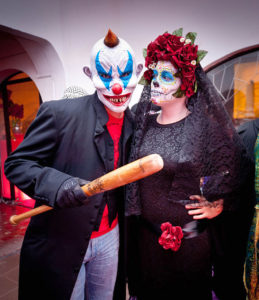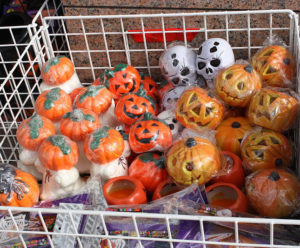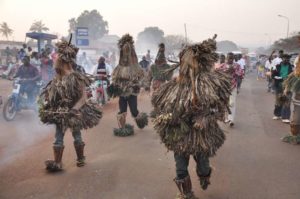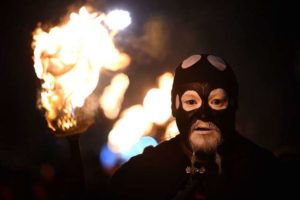By: Tamali Smith
Costume parties, trick or treat, scary movies, haunted houses, parades of revelry in the face of the supernatural and death all highlight the Oct. 31 holiday of festivities: Halloween. The spirit of community reigns as families and friends all dress up for the occasion, decorate and eat tons of candies. These celebrations are most common in American culture; however, this holiday also has its roots and traditions in many other different regions of the world. Although Halloween is synonymous with America, it was not the originator of this holiday.
Halloween, evolving from “All Hallows Eve,” originated in Ireland. The pagan holiday was used to honor the dead where superstitions were told, costumes were worn and people left candies and food out to feed the dead. A widely recognized superstition in Ireland was that the veil between the living and the dead was very thin at this time and souls of the dead would ascend and roam the earth. In order for the spirits to leave the living, persons would carve out turnips and rutabagas, like that of the pumpkin in America. This would be used as a method of protection against the spirits. Today, the Irish celebrate Halloween the same as the US. Adults and children clothe themselves in both fancy and ghostly costumes and go trick or treating. The highlight of the holiday also involves going to fancy costume parties and decorating broomsticks and Jack O’Lanterns. The day is also filled with festivities as the Irish celebrate Halloween with a carnival. Families also commemorate the day by baking the Halloween fruitcake called barmbrack.

Some Mexicans typically dress in Halloween costumes for the Day of the dead: Dia de Los Muertos. Credit: Wikimedia Commons
Another popular Halloween festivity around the world is celebrated in Mexico. This is called “Día de Los Muertos” meaning “The Day of the Dead.” The three-day holiday starts at midnight Oct. 31 and lasts until Nov. 2. Mexicans believe that the gates of heaven open on Nov. 1 to allow the souls of deceased children to reunite with their friends. Later, on Nov. 2, the souls of deceased adults also join family members. According to mentalfloss.com, the Mexican culture for Halloween is commemorated with “in-home alters full of fruit, peanuts, turkey, soda, hot chocolate, water [and]stacks of tortillas.” The article also mentions that a special bread is made and left as offerings for ghosts called pan de Muertos (bread of the dead). Treats and toys are left out for the children’s souls while cigarettes and shots of mezcal are left out for the adults.
Another country that hosts the Halloween holiday is Romania. Romanians refer to this day as the Day of Dracula. This is celebrated with the touring and hosting of parties at Count Dracula’s castle. Although many individuals in Transylvania celebrate this day as a holiday, only a minority of the population celebrate it. This day is not well celebrated among many persons in Romania. On Oct. 31 each year, the city of Transylvania opens the castle of Dracula to host costume parties, have role plays of scenes from the film Dracula and engage in scary story telling. Many families also place garlic at the steps of their houses to ward off evil spirits and to protect them from ghosts.

There are various Halloween decorations of pumpkins in Ireland. Credit: Wikimedia Commons
With less horrific superstitions and costumes of ghostly characters, Italy celebrates Halloween with more tranquility. Ognissanti also referred to as All Saints Day, is celebrated Nov. 1. This day involves the placing of beautiful and colorful flowers on the graves of the dead. Italians also set tables for the dead to visit and also light red candles and place them at the windows after sunset. Recently, Italians also included costuming, parties and baking of Halloween treats.
Other countries, for example, Nigeria, also celebrate Halloween. The tradition lasts up to six months and involves a celebration with feasts, music and masks before the dead return to the spirit world. This day marks the return of the dead to celebrate with friends and family who are currently living. The name of the day is called Awuru Odo Festival and it happens every two years.

Getty Images
India celebrates Halloween somewhat differently; Halloween is called Pitru Paksha. According to hindusantime.com, the dead is taken by a Hindu god to be with the last three generations of the family. During Halloween (Pitru Paksha), the souls of the dead can return to the living for a short while. However, the contrast is that the family has to perform a fire ritual, called Shraddha. This fire ritual helps the soul to find its place and not to roam the earth for eternity. During Halloween, families of the dead celebrate the day by preparing sweet rice and milk, lentils, sweet porridge, beans and pumpkin, served on banana leaves.
While Halloween is highly celebrated in some countries, it is uncommon in others like Jamaica and The Bahamas. Kellie Bertram, a senior from Jamaica majoring in psychology, commented on how Halloween is not a staple in her country.
“Halloween is almost nonexistent in Jamaica. Just a few persons celebrate the holiday. This is normally the upper-class persons of Jamaica, and only a small percentage really do anything geared towards the holiday” Kellie said. “It’s just not a part of our culture.”

Getty Images
She also mentioned that although it is not widely celebrated, the few that do celebrate the occasion do so with small costume parties for adults and trick or treating for the kids. Having experienced the culture of Halloween and its impact on America, Bertram mentioned that she has no problem celebrating it the American way.
In conclusion, Halloween, though celebrated in the United States with a full month of decorations and festivity, some countries or regions have different traditions while other countries have not accepted the tradition as a part of their culture.





